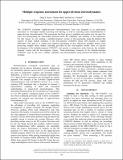Files in this item
Multiple-response assessment for upper-division electrodynamics
Item metadata
| dc.contributor.author | Ryan, Xing | |
| dc.contributor.author | Baily, Charles | |
| dc.contributor.author | Pollock, Steven | |
| dc.contributor.editor | Jones, Dyan | |
| dc.contributor.editor | Ding, Lin | |
| dc.contributor.editor | Traxler, Adrienne | |
| dc.date.accessioned | 2017-02-10T13:30:14Z | |
| dc.date.available | 2017-02-10T13:30:14Z | |
| dc.date.issued | 2016-12-29 | |
| dc.identifier.citation | Ryan , X , Baily , C & Pollock , S 2016 , Multiple-response assessment for upper-division electrodynamics . in D Jones , L Ding & A Traxler (eds) , 2016 Physics Education Research Conference Proceedings . American Association of Physics Teachers , pp. 284-287 , 2016 Physics Education Research Conference , Sacramento , California , United States , 21/07/16 . https://doi.org/10.1119/perc.2016.pr.066 | en |
| dc.identifier.citation | conference | en |
| dc.identifier.isbn | 978-1-931024-30-3 | |
| dc.identifier.isbn | 2377-2379 | |
| dc.identifier.other | PURE: 248713026 | |
| dc.identifier.other | PURE UUID: 4931a090-1833-4205-9609-4815f082c46c | |
| dc.identifier.other | ORCID: /0000-0001-6213-503X/work/41932059 | |
| dc.identifier.other | WOS: 000393035800069 | |
| dc.identifier.uri | https://hdl.handle.net/10023/10268 | |
| dc.description.abstract | The CURrENT (Colorado UppeR-division ElectrodyNamics Test) was designed as an open-ended assessment to investigate student reasoning and learning, as well as assessing course transformations in upper-division electrodynamics. The assessment has been given at multiple universities over the past five years, but hand-grading the open-ended questions limits the scalability and usability of the instrument. For this reason, we are creating a multiple-response version of the assessment, using the database that consists of many student responses to the free-response CURrENT along with research on student difficulties. Our goal is to explore the logistical advantages of this objectively gradable format while preserving insights about student reasoning provided by the free-response format. Here we discuss development of the multiple-response CURrENT and present a comparison study between the multipleresponse version and the free-response version. Some preliminary measures of the multiple-response CURrENT such as the test’s validity, reliability and discrimination using classical test theory are also included. | |
| dc.language.iso | eng | |
| dc.publisher | American Association of Physics Teachers | |
| dc.relation.ispartof | 2016 Physics Education Research Conference Proceedings | en |
| dc.rights | (c) 2016, American Association of Physics Teachers. This material is released under a Creative Commons Attribution 3.0 license. Further distribution of this work must maintain attribution to the published article's author(s), title, proceedings citation, and DOI. | en |
| dc.subject | Assessment | en |
| dc.subject | Electrodynamics | en |
| dc.subject | Physics education research | en |
| dc.subject | Multiple-choice | en |
| dc.subject | QC Physics | en |
| dc.subject | NDAS | en |
| dc.subject.lcc | QC | en |
| dc.title | Multiple-response assessment for upper-division electrodynamics | en |
| dc.type | Conference item | en |
| dc.description.version | Publisher PDF | en |
| dc.contributor.institution | University of St Andrews. School of Physics and Astronomy | en |
| dc.identifier.doi | https://doi.org/10.1119/perc.2016.pr.066 |
This item appears in the following Collection(s)
Items in the St Andrews Research Repository are protected by copyright, with all rights reserved, unless otherwise indicated.

